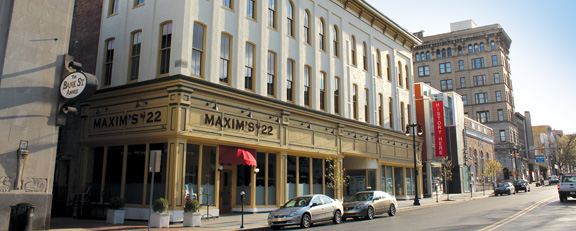Bringing Historic Buildings Back to Life
Ask any longtime Lehigh Valley resident to name their most beloved building in downtown Easton and you’ll likely hear this as the answer – the old Pomeroy’s store on Northampton Street.
An iconic example of the “golden age of downtown shopping,” Pomeroy’s Department Store occupied the structure from 1947 until the end of 1976. The building itself, however, dates back to the late 1800s when William Laubach opened his first dried goods store on the site.
Laubach’s “Trade Palace,” which would become the basis of the present-day structure, was three stories high in the front, with an Italianate style façade, a 28-foot long display window, and a total square footage of 9,520 feet. The grand opening, held on the evening of November 21, 1872, was designed as a social occasion. Laubach hired a full orchestra to provide music and entertainment, and with his family by his side personally greeted the hundreds of people in attendance. This novel approach would cause Laubach’s “opening night” to become one of the most talked about events in Easton’s history for decades to come. Over the next forty years Laubach’s grew into a landmark building in the heart of Easton’s business district. As the company flourished, neighboring buildings were purchased and assimilated into the store’s structure to provide room for expansion. By 1920 Laubach’s had been divided into thirty different departments and employed more than 200 people – including one full-time artist whose sole job was to design and create beautiful window displays. The building had grown to an immense 115,380 square feet and had been updated with the newest and most modern equipment, such as four electric elevators (two for passengers and two for freight), a complex system of aluminum tubes that conveyed the money from purchases in every department down to the cashier’s desk for rapid, convenient service, and an overhead sprinkler system that was touted as “the most powerful fire extinguishing device modern engineering has produced.”
In 1947, at the height of its retail success, Laubach’s was sold to the Allied Stores Corporation, which eventually changed it into Pomeroy’s Department Store. A well-established Pennsylvania chain, Pomeroy’s continued to expand the building throughout the 1950s and 60s by adding an additional 10,000 square feet to create its final footprint. By the 1970s, however, a stagnating national economy had started to take a toll, and Pomeroy’s fell into a steady decline. Finally, in late 1976, the store closed its doors for good – ending more than 100 years of continuous retail business in the Northampton Street building.
Today, the portion of the building that once housed Laubach’s men’s department has been converted into Maxim’s 22, a classic French bistro and brasserie operated by the owners of Easton’s Sette Luna. The old storefront display windows have been replaced with beautiful frosted glass, while the interior has been transformed into the relaxed atmosphere of a French pub.
“I’ve always been a fan of this building,” said Josh Palmer, owner of Maxim’s 22. “It has a great history and we’re thrilled to be a part of its future.”
Maxim 22’s menu features an assortment of classic French dishes as well as a raw bar, burgers, steaks, pates and quiche, while the full-service bar offers twenty-two beers on tap, an extensive list of imported and domestic wines and authentic French cocktails and spirits.
On Lehigh Street in Bethlehem, a similar story has taken place in The Wooden Match – a cigar bar/gastropub located in the old Central New Jersey train line’s Bethlehem station.
Built in 1873, only months after the grand opening of Laubach’s in Easton, the Bethlehem railway station is a striking example of Victorian architecture. As a gateway to major east coast cities such as New York, Buffalo and Philadelphia, the station was a bustling center for travelers and commerce throughout the early 20th Century.
Two of its most famous visitors include President Theodore Roosevelt, who stopped at the station to greet hundreds of Lehigh Valley natives as part a nationwide “whistle stop” tour in 1912, and President Harry S. Truman, who delivered a campaign speech from the rear platform of his train car in October of 1948.
For residents of the Lehigh Valley, however, the best memories of the train station are often more personal. Steve DiDonato, co-owner of The Wooden Match, arrived at the restaurant early one morning to find an elderly woman, well into her 80s, standing on the platform, gazing out at the long abandoned tracks. The woman told him that, decades earlier, she left her native Poland and immigrated to the United States. After processing in through Ellis Island, this was the train station through which she arrived in the Lehigh Valley and began her new life in America.
Today, The Wooden Match has kept its past alive by carefully integrating original features into its current design. The old ticket booth has been converted into the bar, which features 50 bottled beers, a constantly rotating tap selection and a wide array of craft beers. The old Western Union office space now houses the Cigar Blend Room, where patrons can choose from over one hundred hand-rolled cigars. Sprinkled throughout the décor are historically significant items, including several original train station lights (now converted into lanterns) and black and white photographs of both
presidential visitors.
Plans are currently underway to convert The Wooden Match’s top floor into a private VIP room where guests can enjoy a stunning view of historic Bethlehem. The owners have also recently purchased the old freight building, located directly next door to The Wooden Match, and intend to convert it into a wine bar and event center for private parties.





